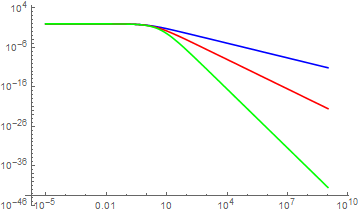Perhaps this is trivial but I would like to plot the following function:
\begin{equation}
p(t)=e^{\left( -\frac{d}{1-c}\right)\left[ W_0\left[B(1+x/r)^{1/d}\right]-W_0[B] \right]}
\end{equation}
where $W_k$ is the Lambert-W function for the $k=0$ branch and
\begin{equation}
B=\frac{(1-c)r}{1-(1-c)r}e^{\frac{(1-c)r}{1-(1-c)r}}
\end{equation}
by the same way they are done in the attached picture below. I am not really sure how to make a $(\log p(x),x)$ plot, but I guess that if I could do one, the $(-\log p(x),x)$ plot would be by ploting $p^{-1}(x)$?

My (poor) attempt so far is the following:
c = 0.99999
r = 0.0001
B = ((1 - c) r)/(1 - (1 - c) r) Exp[((1 - c) r)/(1 - (1 - c) r)]
p = Table[ Exp[(-1/(1 - c)) (ProductLog[0, B*(1 + x/r)^(1/1)] -
ProductLog[0, B])], {d, 0.5, 2, 0.1}];
LogPlot[Evaluate[p^-1, {x, 0, 10}], PlotRange -> {10^-1, 10^2}]
But even for the first one I am not able to get them correct.
I would really appreciate your help. Thank you.



pa function instead of a table maybe? $\endgroup$